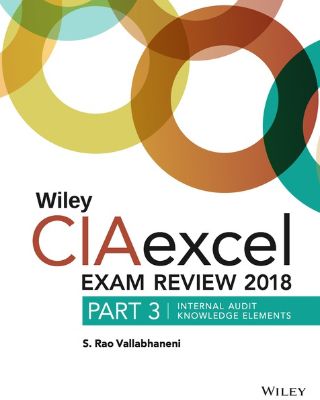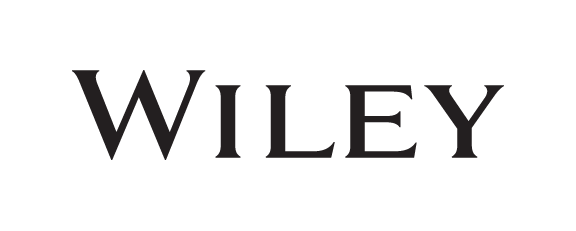Wiley CIAexcel Exam Review 2018, Part 3: Internal Audit Knowledge Elements (Print Friendly)
6.590 kr.

Lýsing:
n/aAnnað
- Höfundur: Wiley
- Útgáfudagur: 12/2017
- Hægt að prenta út 120 bls.
- Hægt að afrita 120 bls.
- Format:Page Fidelity
- ISBN 13: 9781119482895
- Print ISBN: 9781119482857
- ISBN 10: 1119482895
Efnisyfirlit
- Wiley CIAexcel Exam Review 2017
- Contents
- Preface
- CIA Exam January Summary of Standards Changes
- CIA Exam Study Preparation Resources
- CIA Exam-Taking Tips and Techniques
- CIA Exam Content Specifications
- Domain 1 Governance and Business Ethics (5–15%)
- 1.1 Corporate/Organizational Governance Principles
- (a) What Is a Corporation?
- (b) What Is Corporate Governance?
- (c) Components of Corporate Governance
- (d) Corporate Governance Problems
- (e) Corporate Governance Standards
- (f) Corporate Governance Principles
- (g) Need for Board Independence
- (h) Insider Trading Scandals
- (i) Board Member Liabilities
- (j) Improving Corporate Governance
- (k) Global Practices in Corporate Governance
- (l) Roles of the Board of Directors
- (m) Roles of Chief Executive Officers and Senior Executives
- (n) Roles and Responsibilities of the Chief Governance Officer
- (o) Roles and Responsibilities of the Audit Committee
- (p) Roles and Responsibilities of Other Committees
- (q) Various Types of Audits in Governance
- 1.2 Business Ethics
- (a) Law, Ethics, and Economics
- (b) Basic Ethical and Legal Principles
- (c) Codes of Conduct
- (d) Financial Disclosures
- (e) U.S. Foreign Corrupt Practices Act
- (f) U.S. Federal Securities Regulations
- (g) U.S. Sarbanes-Oxley Act of 2002
- (h) Key Ethical Principles
- (l) Ethical Dilemmas
- (j) Transparency International’s Corruption Perceptions Index
- (k) Types of Ethics
- (l) Models of Management Ethics
- (m) Elements of Making Moral Judgments
- (n) Roles and Responsibilities of Gatekeepers
- (o) Roles and Responsibilities of the Chief Ethics Officer
- (p) Roles and Responsibilities of the Chief Legal Officer
- (q) Conduct an Ethics Audit
- 1.3 Corporate Social Responsibility
- (a) What Is a Corporate Social Responsibility?
- (b) Pyramid of Corporate Social Responsibility
- 1.4 Sample Practice Questions
- 1.1 Corporate/Organizational Governance Principles
- Domain 2 Risk Management (10–20%)
- 2.1 Corporate Risk Management
- 2.2 Risk Management Methodology
- (a) Risk Assessment
- (b) Risk Mitigation
- (c) Risk Monitoring
- 2.3 Various Types of Risks
- (a) Human Capital Risk
- (b) Risk Caused By Management
- (c) Strategic and Business Risk
- (d) Financial and Economic Risk
- (e) Product and Service Quality Risk
- (f) Production and Process Risks
- (g) Service and Process Risk
- (h) Organizational Risk
- (i) Contract Risk
- (j) Information Risk
- (k) Trade Risk
- (l) Control Risk
- (m) Research and Development Risk
- (n) Technology Risk
- (o) Digital and Security Risk
- (p) Project and Program Risk
- (q) Communications Risk
- (r) Regulatory and Reputation Risk
- (s) Environmental Risks
- (t) Outsourcing Risks
- (u) Privacy Risk
- (v) Implementation and Operational Risk
- (w) Marketing and Sales Risks
- (x) Natural and Catastrophic Risks
- (y) Legal and Reputation Risk
- (z) International Risk
- 2.4 Risk Management Tools
- (a) Business Impact Analysis
- (b) Cost/Benefit Analysis
- (c) SWOT Analysis
- (d) Sensitivity Analysis
- (e) Fit-Gap Analysis
- (f) Option Analysis
- (g) Economic Analysis
- (h) Expected Value Analysis
- (i) Subjective Scoring
- (j) Quantitative Methods
- (k) Qualitative Methods
- 2.5 Managing Corporate Risks
- 2.6 Enterprise Risk Management
- (a) ERM Defined
- (b) IIA Survey Results
- (c) Approaches to ERM
- (d) ERM Tools
- (e) Implementation of ERM
- (f) Role of Internal Auditing in ERM Implementation
- (g) Roles and Responsibilities of Chief Risk Officer
- (h) Conduct Risk Management Audit
- 2.7 Sample Practice Questions
- Domain 3 Organizational Structure, Business Processes, and Risks (15–25%)
- 3.1 Risk/Control Implications of Different Organizational Structures
- (a) Organization Defined
- 3.2 Types of Organizational Structures
- (a) Contingency Design Alternatives
- (b) Types of Departmentalization
- (c) New Organizational Configurations
- 3.3 Schemes in Various Business Cycles
- (a) Sales Pricing Objectives and Policies
- (b) Procurement and Supply Chain Management
- (c) Marketing Product Life Cycles
- 3.4 Business Process Analysis
- (a) Workflow Analysis
- (b) Bottleneck Management
- (c) Theory of Constraints
- (d) Business Process Review
- (e) Benchmarking
- (f) Design of Performance Measurement Systems
- (g) Specific Performance Measures
- (h) Balanced Scorecard System
- (i) Production Process Flows
- 3.5 Inventory Management Techniques and Concepts
- (a) Independent Demand Inventory Systems
- (b) Dependent Demand Inventory Systems
- (c) Inventory Levels and Investment Levels
- (d) Efficient Inventory Management
- (e) Investment in Inventory
- (f) Optimal Order Quantity
- (g) Reorder Point
- (h) Inventory Decisions
- (i) Calculating How Much to Order
- (j) EOQ Assumptions
- (k) Sensitivity Analysis and EOQ
- (l) Calculating When to Order
- (m) Safety Stock and Stock-outs
- (n) ABC Inventory Control System
- (o) Effects of Inflation on Inventory Management
- (p) Just-in-Time Systems
- (q) Materials Requirements Planning
- (r) Distribution Systems
- (s) Production Scheduling and Control Systems
- 3.6 Electronic Data Systems
- (a) Electronic Funds Transfer
- (b) Electronic Commerce
- (c) Mobile Commerce
- (d) Electronic Auctions
- (e) Electronic Data Interchange
- 3.7 Business Development Life Cycles
- (a) Overview
- (b) Causes behind the Business Cycles and Business Activity
- (c) Growth Concepts
- 3.8 International Organization for Standardization Framework
- (a) ISO Certification Process
- (b) Overall Benefits of ISO Standards
- (c) Specific Benefits of ISO 9000 Standards
- (d) Specific ISO Standards
- 3.9 Outsourcing Business Processes
- (a) Scope of Outsourcing
- (b) Reasons for Outsourcing
- (c) Risks in Outsourcing
- (d) Benefits of Outsourcing
- (e) Vendor Governance
- (f) Service-Level Agreements
- (g) Third-Party Organizations
- (h) Managing Third-Party Organizations
- 3.10 Sample Practice Questions
- 3.1 Risk/Control Implications of Different Organizational Structures
- Domain 4 Communication (5–10%)
- 4.1 Communication Skills
- (a) Communication Process
- (b) Barriers to Communication
- (c) Organizational Dynamics
- (d) Impact of Computerization on Communication
- 4.2 Stakeholder Relationships
- (a) Handling Shareholders and Investors
- (b) Handling Creditors
- (c) Dealing with Stock Markets
- (d) Dealing with Investment Analysts
- (e) Handling Employees
- (f) Dealing with Labor Unions
- (g) Handling Regulators and Government Authorities
- (h) Handling Suppliers, Vendors, Contractors, and Customers
- (i) Dealing with Purchasing Agents, Buyers, or Commodity/Service Experts
- (j) Dealing with Marketing and Salespeople
- (k) Handling Related Parties and Third Parties
- (l) Handling Business Mergers, Acquisitions, and Divestitures
- 4.3 Sample Practice Questions
- 4.1 Communication Skills
- Domain 5 Management and Leadership Principles (10–20%)
- 5.1 Strategic Management
- (a) Strategic Management Defined
- (b) Strategic Planning Process
- (c) Global Analytical Techniques
- (d) Industry Environments
- (e) Strategic Decisions
- (f) Portfolio Techniques of Competitive Analysis
- (g) Forecasting
- (h) Quality Management
- (i) Decision Analysis
- 5.2 Organizational Behavior
- (a) Organizational Theory
- (b) Organizational Behavior
- (c) Group Dynamics
- (d) Human Resource Processes
- (e) Risk/Control Implications of Different Leadership Skills
- 5.3 Management Skills
- (a) Leadership Skills
- (b) Group Synergy through Team Building
- 5.4 Conflict Management
- (a) Negotiating Skills
- (b) Conflict Management
- (c) Conflict Resolution
- (d) Added-Value negotiating
- 5.5 Project Management and Change Management
- (a) Project Management Techniques
- (b) Change Management Methods
- 5.6 Sample Practice Questions
- 5.1 Strategic Management
- Domain 6 Information Technology and Business Continuity (15–25%)
- 6.1 Security
- (a) Information Security Objectives
- (b) System Security
- (c) Information Protection
- (d) Identification and Authentication
- (e) Encryption
- 6.2 Application Development
- (a) Systems Development Methodology
- (b) Information Systems Development
- (c) Application Development
- (d) Change Management and Control
- (e) End User Computing
- (f) Knowledge-Based Systems
- 6.3 System Infrastructure
- (a) Information Technology Control Frameworks
- (b) Operating Systems, Mainframe Computers, Terminals, Workstations, and Servers
- (c) Database Systems and Cloud Computing Systems
- (d) Functional Areas of Information Technology Operations
- (e) Enterprise-Wide Resource Planning System, Customer Relationship Management System, and Software
- (f) Data and Network Communications and Connections
- 6.4 Business Continuity
- (a) Business Continuity Management
- (b) IT-Focused Continuity Management
- (c) Roles and Responsibilities of Business Continuity Manager or Executive
- (d) Relationship of Business Continuity Management to ISO Standards
- 6.5 Sample Practice Questions
- 6.1 Security
- Domain 7 Financial Management (13–23%)
- 7.1 Financial Accounting and Finance
- (a) Basic Concepts and Underlying Principles of Financial Accounting
- (b) Intermediate Concepts of Financial Accounting
- (c) Advanced Concepts of Financial Accounting
- (d) Financial Statement Analysis
- (e) Types of Debt and Equity
- (f) Financial Instruments
- (g) Cash Management
- (h) Valuation Models
- (i) Methods to Rank Investment Projects
- (j) Cost of Capital Evaluations
- (k) Taxation Schemes
- (l) Differences Between Tax Reporting and Financial Reporting
- (m) Mergers, Acquisitions, and Divestitures
- 7.2 Managerial Accounting
- (a) Managerial Accounting: General Concepts
- (b) Costing Systems
- (c) Cost Concepts
- (d) Relevant Costs
- (e) Cost-Volume-Profit Analysis
- (f) Transfer Pricing
- (g) Responsibility Accounting
- (h) Operating Budgets
- 7.3 Sample Practice Questions
- 7.1 Financial Accounting and Finance
- Domain 8 Global Business Environment (0–10%)
- 8.1 Economic/Financial Environments
- (a) Organization Structures
- (b) Types of International Strategies
- (c) International Strategic and Tactical Objectives
- (d) Technology and Global Strategy
- (e) Forms of International Business and Marketing Strategies
- 8.2 Cultural/Political Environments
- (a) Different Local/Regional Cultures
- (b) Cross-Cultural Negotiations
- (c) Global Mindsets
- 8.3 Legal and Economic Concepts
- (a) Contracts
- (b) Key Economic Indicators
- 8.4 Impact of Government Legislation and Regulationon Business
- (a) Governmental Legislation and Regulation
- (b) Government’s Monitoring of Environmental Issues
- (c) Specific Trade Legislation and Regulations
- 8.5 Sample Practice Questions
- 8.1 Economic/Financial Environments
- Sample Practice Questions, Answers, and Explanations
- Glossary
- Index
UM RAFBÆKUR Á HEIMKAUP.IS
Bókahillan þín er þitt svæði og þar eru bækurnar þínar geymdar. Þú kemst í bókahilluna þína hvar og hvenær sem er í tölvu eða snjalltæki. Einfalt og þægilegt!Rafbók til eignar
Rafbók til eignar þarf að hlaða niður á þau tæki sem þú vilt nota innan eins árs frá því bókin er keypt.
Þú kemst í bækurnar hvar sem er
Þú getur nálgast allar raf(skóla)bækurnar þínar á einu augabragði, hvar og hvenær sem er í bókahillunni þinni. Engin taska, enginn kyndill og ekkert vesen (hvað þá yfirvigt).
Auðvelt að fletta og leita
Þú getur flakkað milli síðna og kafla eins og þér hentar best og farið beint í ákveðna kafla úr efnisyfirlitinu. Í leitinni finnur þú orð, kafla eða síður í einum smelli.
Glósur og yfirstrikanir
Þú getur auðkennt textabrot með mismunandi litum og skrifað glósur að vild í rafbókina. Þú getur jafnvel séð glósur og yfirstrikanir hjá bekkjarsystkinum og kennara ef þeir leyfa það. Allt á einum stað.
Hvað viltu sjá? / Þú ræður hvernig síðan lítur út
Þú lagar síðuna að þínum þörfum. Stækkaðu eða minnkaðu myndir og texta með multi-level zoom til að sjá síðuna eins og þér hentar best í þínu námi.
Fleiri góðir kostir
- Þú getur prentað síður úr bókinni (innan þeirra marka sem útgefandinn setur)
- Möguleiki á tengingu við annað stafrænt og gagnvirkt efni, svo sem myndbönd eða spurningar úr efninu
- Auðvelt að afrita og líma efni/texta fyrir t.d. heimaverkefni eða ritgerðir
- Styður tækni sem hjálpar nemendum með sjón- eða heyrnarskerðingu
- Gerð : 208
- Höfundur : 11863
- Útgáfuár : 2017
- Leyfi : 379


